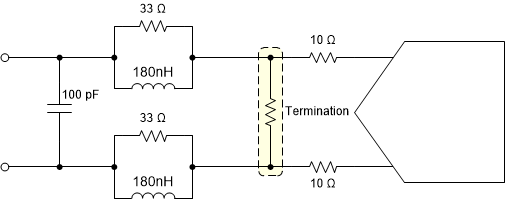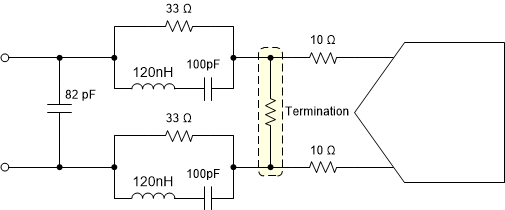JAJSL69A February 2021 – October 2022 ADC3581 , ADC3582 , ADC3583
PRODUCTION DATA
- 1 特長
- 2 アプリケーション
- 3 概要
- 4 Revision History
- 5 Pin Configuration and Functions
-
6 Specifications
- 6.1 Absolute Maximum Ratings
- 6.2 ESD Ratings
- 6.3 Recommended Operating Conditions
- 6.4 Thermal Information
- 6.5 Electrical Characteristics - Power Consumption
- 6.6 Electrical Characteristics - DC Specifications
- 6.7 Electrical Characteristics - AC Specifications
- 6.8 Timing Requirements
- 6.9 Typical Characteristics - ADC3581
- 6.10 Typical Characteristics - ADC3582
- 6.11 Typical Characteristics - ADC3583
- 7 Parameter Measurement Information
- 8 Detailed Description
- 9 Application Information Disclaimer
- 10Device and Documentation Support
- 11Mechanical, Packaging, and Orderable Information
パッケージ・オプション
メカニカル・データ(パッケージ|ピン)
- RSB|40
サーマルパッド・メカニカル・データ
- RSB|40
発注情報
8.3.1.2.1 Sampling Glitch Filter Design
The front end sampling glitch filter is designed to optimize the SNR and HD3 performance of the ADC. The filter performance is dependent on input frequency and therefore the following filter designs are recommended for different input frequency ranges as shown in Figure 8-4 and Figure 8-5.
 Figure 8-4 Sampling glitch filter example for input frequencies from DC to 30 MHz
Figure 8-4 Sampling glitch filter example for input frequencies from DC to 30 MHz Figure 8-5 Sampling glitch filter example for input frequencies from 30 to 70 MHz
Figure 8-5 Sampling glitch filter example for input frequencies from 30 to 70 MHz